We Had A Full Week Together
Thoughts
VIII
We had a full week together
I was embarrassed when he told to the participants of the first immersion program that I was naturally crooked to the left. I know that my inherent response to collection is shifting my pelvis to the left but he could have been more elegant in his description. I am aware of this tendency but you have to remember that I am a horse. My initial impulse is always to protect whatever muscle imbalance I have. I know ultimately that as he straightens his vertebral column walking by my side, he is inviting me to work with him. I know that the most efficient way for me to follow his back muscles adjustments is to coordinate my own back muscles creating longitudinal flexion. I know that doing so I achieve greater control and also comfort in my body, but I primarily live in the moment. My initial impulse is to indulge my back muscles’ imbalance and I bend my spine laterally. If he were a horse he would understand my mental processing, but he is a man; do I need to say more?
Then, he explained to the participants, he is a horse; he is primarily living in the moment and his natural tendency is to indulge is back muscles imbalance. He knows that he would be more comfortable flexing the spine longitudinally but his natural impulse is to protect his body state. Since he knows that ultimately longitudinal flexion will give him greater body control and physical comfort, he let me guide him toward comfort. He is willingly responding to my suggestion which is straightening his body by placing his shoulders in front of his haunches.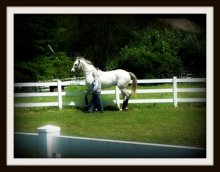 I don’t know if I told you but sometime he really annoys me. Then, I deliberately stiffened my neck and bounce a little bit in the air. I had absolutely no reason to do that beside the fact that I hate to feel that I am predictable. He commented then, sometime he does react like that. He does not like to think that he is predictable. !#!????#! I will not translate because it would not pass the editing.
I don’t know if I told you but sometime he really annoys me. Then, I deliberately stiffened my neck and bounce a little bit in the air. I had absolutely no reason to do that beside the fact that I hate to feel that I am predictable. He commented then, sometime he does react like that. He does not like to think that he is predictable. !#!????#! I will not translate because it would not pass the editing.
However, I truly surprised him yesterday. He was expecting that the presence of auditors around the ring would obsess me and that the demonstration might not be as clear as he would like. The demo was about distinguishing changes in the kinematics of my hind and front legs in relation to proper or improper coordination of my back muscles. He was hoping to show the difference in the spring of my forelegs movements as well as the ease of my body motion when I am working at my natural cadence verses limbs kinematics abnormalities and stiffening of my back muscles when I am working at faster speed.
Anticipating some creativity from my part, he recorded the previous lunging session thinking that even if I blow it, he will have a document to give to the participants. 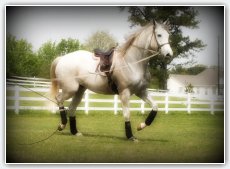 He did not realize that I was firmly decided to steal the show; I like to show off. I was focused and cool during the whole lunging session. Truly, I was better during the live demonstration than during the rehearsal recorded on the previous day.
He did not realize that I was firmly decided to steal the show; I like to show off. I was focused and cool during the whole lunging session. Truly, I was better during the live demonstration than during the rehearsal recorded on the previous day.
Physically, I do enjoy trotting, walking and cantering at my natural cadence. There is a feeling of ease that I lose immediately when I speed up. Each time, he brings me back to my natural cadence and together we are working through the entire ring between straight lines and circles. I had my instant of personal amusement when he was explaining to the auditors the cue that he is using for halt. He holds the lunge whip horizontally, parallel to the ground as well as parallel to me. I have learned to stop at this signal and stay parallel to the whip instead of facing him. As I decided to trot on my own, he placed the lunge whip horizontal to illustrate his explanation. I acted like I did not know the cue and kept trotting. He commented, of course, since horses always make you a liar, he is not going to respond today. This is where I decided to stop into a perfectly square halt. He was speechless and I know how hard it is to get him speechless.
Today after work, we went out for a walk around the farm. Half way through the walk, I impulsively picked up the trot. I kept it collected hoping to show him that I can be creative and technically correct all together. He touched my neck commenting on the quality of my trot, it is then that the stone started to walk between my legs. I do eat barley in some occasions, but I don’t drink beer. It was indeed a walking stone. I carefully placed my feet around the stone wondering what would happen if I touched it. He was now laughing. Not only can you sustain a nicely collected trot on your own but also you are simultaneously able to place your feet with great precision. You did not even touch the turtle that was trapped between your big feet. I guess, with all the canter that you are doing trough the rolling hills of your pasture, you must have developed the muscle spindles which allow fine motor control muscles and great precision. I argued in my mind about my “big feet”, but he was in his thoughts and he did not listen to me. You know sometime, experience and science contradict each other, at least apparently. In 1976, James Rooney stated that horses do not have sophisticated control of their body due to the absence of direct pyramidal pathways. Experience shows that you do, indeed, have sophisticated control of your body. The response came recently with the discoveries that muscles with fewer cells per motor unit allow great precision. 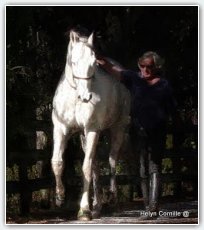
Listening to him think about modern studies, I find that I apply scientific findings the way he does. Greater knowledge of my physiology allows me to better understand how my body functions. His whole education is about guiding my brain through better orchestration of my physique. He always has been a strong advocate of letting me process the correct coordination. I have observed through the evolution of our work that new scientific discoveries have increase his belief in an education based on partnership. One partner, which is he, having the capacity of analysis and the other, which is me, having the capacity to process the most efficient body coordination. Referring to the work in hand, he told to this week end’s Immersion (I) participants, the first day of your work in hand experience, you will feel that you have no control whatsoever. Two weeks later, it will seem that you still have no control but you will get used to it. He then added; the horse will still be by your side working with you. He could have left you any time he wished. Instead, the horse will stand by you, concentrating and responding to your minute back muscles adjustments. All the techniques designed to dominate the horse are violating the horse’s willingness and sensitivity.
He often talks about our physique being tiers of systems within a system within a system. There are layers into our control system that conventional riding principles are not aware of. For instance, primitive equitation believes that the rider’s spurs contract muscles that move the hind legs. In reality, “Various networks at different levels of the nervous system coordinate different motor patterns, be the eye or hand movements or those that underlie respiration, locomotion and posture. Together, these networks provide a motor infrastructure that can be used by the nervous system to generate the elegant movements of a ballet dancer or the demanding postural control of a tight rope walker. Some networks are present at birth, whereas others mature during development to be modified and perfected through learning.” (1) Difficulties may occur at the level of the network itself or at the level of the stimulus sent out by the brain, or both. For instance, I used to have a problem at the level of calcium regulation which induced sharp pain in my back muscles. The problem had to be addressed at the chemical level which he did through proper nutrition. Also, regular training helped at the muscular level but without recreating proper balance at the level of calcium regulation, the physical work would not have resolved the issue.
We have in fact in our spinal cord, all the basic network coordinating locomotor activity. “In all classes of vertebrates, the spinal cord contains the basic network that coordinate locomotor activity, be it swimming, flying, or walking.” (2) The spinal cord can generate stereotypic locomotor movements such as walking, even when it has no connection to the brainstem but as long as a certain number of axons to the brainstem remain intact. Several laboratories have explored the possibility that human patients with a spinal cord lesion that had bound them to a wheelchair could be trained to walk again. They succeed indeed but as long as they are trained every day.
The practical application of pertinent research studies leads him to never ask for a move, even one as simple as lateral bend, without predisposing my thoracolumbar spine for the effort. He prepares my vertebral column for lateral bending creating first longitudinal flexion because longitudinal flexion does makes lateral bending easier. Knowing that lateral bending is always coupled with transversal rotation, he never use rein actions and other cues which could stimulate the wrong rotation. Simplistic riding techniques such as bending the neck side way by action on the inside rein, creates lateral bending of the neck on a superficial level, but also induces inverted rotation on a deeper level. Such inverted rotation, which is also referred to as contrary movement, induces frictions and strains on our vertebral column structure.
The more I work, the sounder I am. We rarely see the vet, although, the other day, the vet was the involuntary subject of a funny event. The vet was there for our spring shots. The previous night, Manchester worried me talking about hock injections. I know that he never had to inject the hocks of any of the horses he has had in training, even the ones who came with a history of hock problems. Still obsessed by Manchester’s conversation, I panicked when I saw the vet with a syringe in his right hand. I walked out of my stall keeping my hocks as close to each other as possible trying to cover them my tail. The vet approached my neck and I realized then the purpose of his visit. Back in my stall, I asked Manchester if he knew that the vet was coming this morning. He says no but I did not know that you had some cat walk type of training. His glory was ephemeral; he does not like needles and it was now his turn. Walking back in his stall, Manchester halted half way through the door telling me, 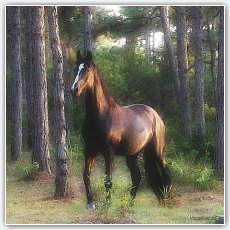 OK, I was a wimp, give me your best shot. Well I told him, your body shaking was quite cool but your foot work needs practice.
OK, I was a wimp, give me your best shot. Well I told him, your body shaking was quite cool but your foot work needs practice.
In the hunter and dressage ring, fulfilling the judging standard is the purpose of the training techniques. Problems arise when judging standards are applied as training technique. The alarming rate of hunter/jumpers’ injury is due to the fact that the requirements based on which the horse is judged, in the show ring, demand a specific education. Repeating during daily exercise the requirements rewarded in the show ring, cannot complete such education. The same can be said for dressage. At the best, judging standards describe how the performance is supposed to look. Soundness demands a little more knowledge and respect of our biological mechanism. Muscles and bones actively remodel in response to changes in exercise. Actually, mechanical stresses can also directly alter many cellular processes. Living systems are neither homogeneous nor isotropic, which means having the same properties in all directions. In tissues and cells, mechanical deformations which are imposed by the physical demands of the performances, must necessarily result in a coordinated structure rearrangement on many different levels of our system. When focusing on neck posture or other judging standards, training techniques only address one level of our complex structure creating problems at another scale.
We are primarily creatures of motion and the most appropriated way to verify that our systems works efficiently is definitively through the quality of movements including our gaits. Unfortunately, when it comes to gaits and movements, judging standards are not valuable references. Judging standards are based on antiquated understanding of our physiology and have not evolved with knowledge. Breeding programs are creating extravagant movers that training techniques are unable to educate properly. They are exuberant but dysfunctional athletes. They are winners on one scale but losers on another. Their front limbs’ extravagance wins the judges’ votes but their vertebral column suffers excruciating stresses. They show, then they are sold and they never show again because if they were humans they would be bond to a wheel chair. The problem is that lameness is so common in the show ring that lameness is rewarded. They were watching the video of a horse literally limping on three legs in a dressage ring. I watched through the window of the conference room and I was appalled. At several instances the pain that this poor horse exhibited cramped my stomach and I heard him saying, can you believe that they scored this horse 68.9%.
Lameness is the outcome of injury and associated pain. At a earlier stage, gait abnormality, which later will became lameness, is the outcome of vertebral column dysfunction and associated discomfort. At this stage, lameness would be prevented if the training techniques were focusing on how our physique executes the performance instead of how the performance is supposed to look. He teaches me how to perform at ease and doing so, he creates peace in my mind. On the race track my life was about pain, pain during exercise and pain while recovering from exercise. I revolted rearing higher, stronger and more often. He did not address my behavior as a behavior issue but instead he looked for the physical reason that triggered my behavior. Recently, Carole Fureix PhD from France studied the relation between pain and aggression in horses, “Partners with bad temper: Reject or Cure?” 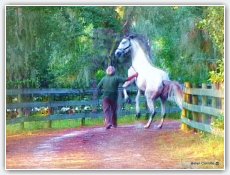 Carole found out that 73% of the horses participating to the study were severely affected by vertebral problems.
Carole found out that 73% of the horses participating to the study were severely affected by vertebral problems.
Retrospectively, I regret that I was a little cocky when they recorded my lunging session the day before the demonstration. I am proud to be part of a movement which is aiming, solely, to improve our education. There is a long way to go starting by redefining what his authentic forward movement and what the gaits of a functional horse really look like, verses those gaits rewarded in both the dressage and jumping ring. When I was trotting at my natural cadence, the participants of the immersion program clearly remarked about the difference in the quality of my trot and the comfort of my body movements. He told me on the way back to my stall, as you can see, peoples who do care for the horse are perfectly capable to liberate their mind from stereotypes and clearly distinguish a functional horse from a dysfunctional athlete.
Chazot
Jean Luc Cornille
References,
(1& 2) (Sten Grillner, The motor infrastructure from ion channel to neuronal networks.Nature review, neuroscience, Volume 4, July 2003)


